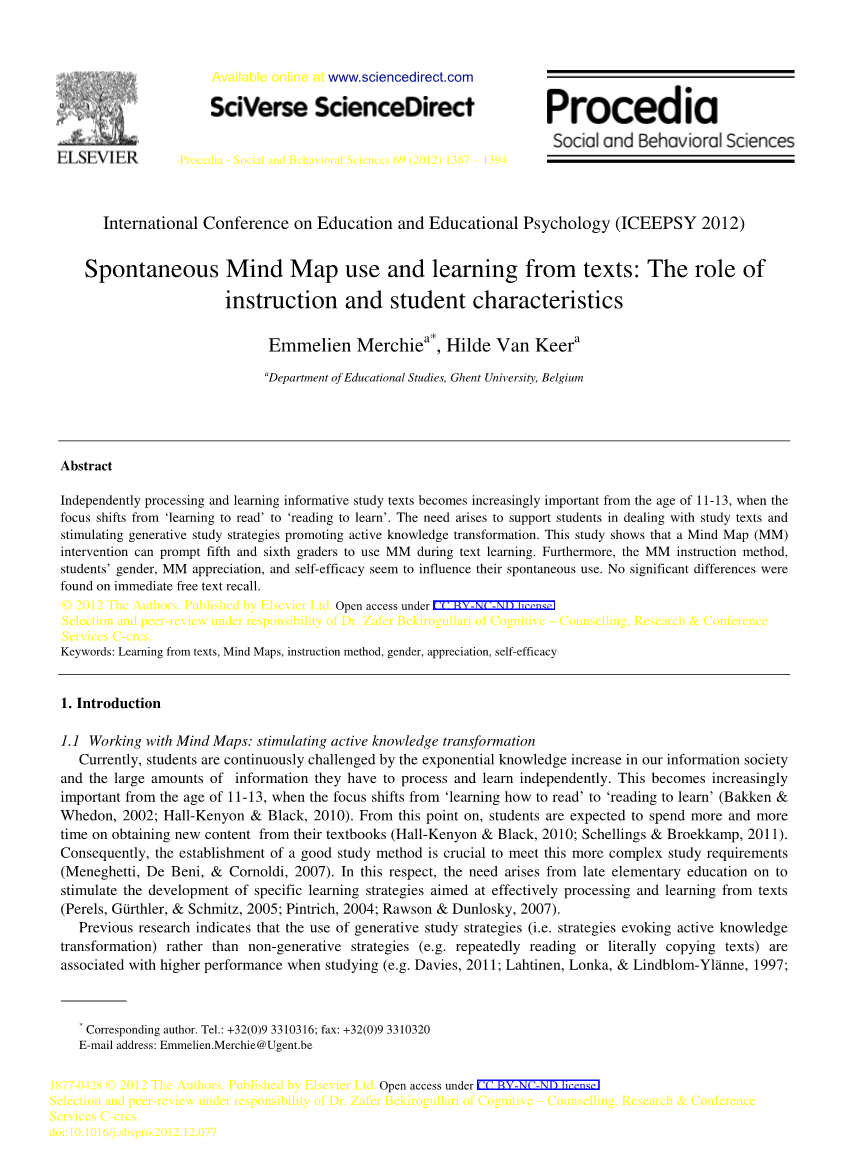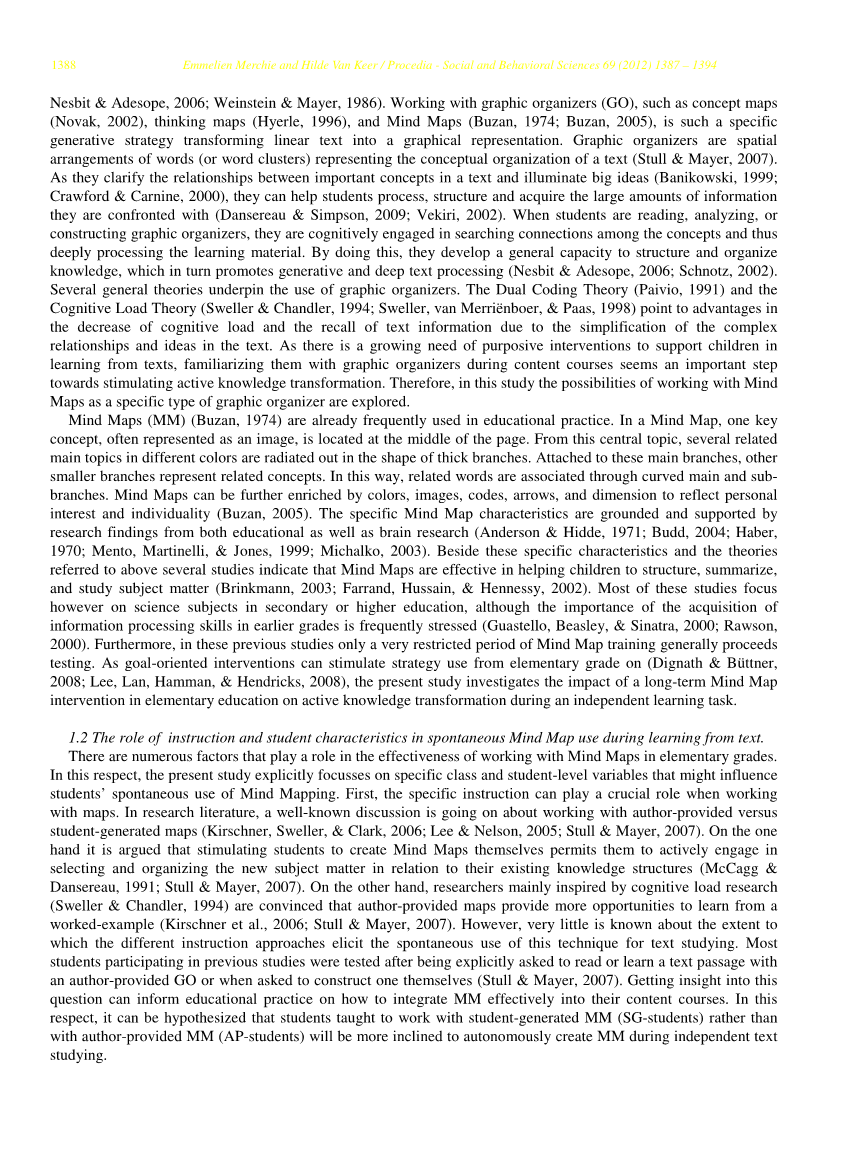

英语原文共 8 页,剩余内容已隐藏,支付完成后下载完整资料
Spontaneous Mind Map use and learning from texts: The role of instruction and student characteristics
Abstract
Independently processing and learning informative study texts becomes increasingly important from the age of 11-13, when the focus shifts from lsquo;learning to readrsquo; to lsquo;reading to learnrsquo;. The need arises to support students in dealing with study texts and stimulating generative study strategies promoting active knowledge transformation. This study shows that a Mind Map (MM) intervention can prompt fifth and sixth graders to use MM during text learning. Furthermore, the MM instruction method, studentsrsquo; gender, MM appreciation, and self-efficacy seem to influence their spontaneous use. No significant differences were found on immediate free text recall.
1.Introduction
1.1Working with Mind Maps: stimulating active knowledge transformation
Currently, students are continuously challenged by the exponential knowledge increase in our information society and the large amounts of information they have to process and learn independently. This becomes increasingly important from the age of 11-13, when the focus shifts from lsquo;learning how to readrsquo; to lsquo;reading to learnrsquo; (Bakken amp; Whedon, 2002; Hall-Kenyon amp; Black, 2010). From this point on, students are expected to spend more and more time on obtaining new content from their textbooks (Hall-Kenyon amp; Black, 2010; Schellings amp; Broekkamp, 2011). Consequently, the establishment of a good study method is crucial to meet this more complex study requirements (Meneghetti, De Beni, amp; Cornoldi, 2007). In this respect, the need arises from late elementary education on to stimulate the development of specific learning strategies aimed at effectively processing and learning from texts (Perels, Guuml;rthler, amp; Schmitz, 2005; Pintrich, 2004; Rawson amp; Dunlosky, 2007).
Previous research indicates that the use of generative study strategies (i.e. strategies evoking active knowledge transformation) rather than non-generative strategies (e.g. repeatedly reading or literally copying texts) are associated with higher performance when studying (e.g. Davies, 2011; Lahtinen, Lonka, amp; Lindblom-Ylauml;nne, 1997;Nesbit amp; Adesope, 2006; Weinstein amp; Mayer, 1986). Working with graphic organizers (GO), such as concept maps (Novak, 2002), thinking maps (Hyerle, 1996), and Mind Maps (Buzan, 1974; Buzan, 2005), is such a specific generative strategy transforming linear text into a graphical representation. Graphic organizers are spatial arrangements of words (or word clusters) representing the conceptual organization of a text (Stull amp; Mayer, 2007). As they clarify the relationships between important concepts in a text and illuminate big ideas (Banikowski, 1999; Crawford amp; Carnine, 2000), they can help students process, structure and acquire the large amounts of information they are confronted with (Dansereau amp; Simpson, 2009; Vekiri, 2002). When students are reading, analyzing, or constructing graphic organizers, they are cognitively engaged in searching connections among the concepts and thus deeply processing the learning material. By doing this, they develop a general capacity to structure and organize knowledge, which in turn promotes generative and deep text processing (Nesbit amp; Adesope, 2006; Schnotz, 2002). Several general theories underpin the use of graphic organizers. The Dual Coding Theory (Paivio, 1991) and the Cognitive Load Theory (Sweller amp; Chandler, 1994; Sweller, van Merrieuml;nboer, amp; Paas, 1998) point to advantages in the decrease of cognitive load and the recall of text information due to the simplification of the complex relationships and ideas in the text. As there is a growing need of purposive interventions to support children in learning from texts, familiarizing them with graphic organizers during content courses seems an important step towards stimulating active knowledge transformation. Therefore, in this study the possibilities of working with Mind Maps as a specific type of graphic organizer are explored.
Mind Maps (MM) (Buzan, 1974) are already frequently used in educational practice. In a Mind Map, one key concept, often represented as an image, is located at the middle of the page. From this central topic, several related main topics in different colors are radiated out in the shape of thick branches. Attached to these main branches, other smaller branches represent related concepts. In this way, related words are associated through curved main and sub- branches. Mind Maps can be further enriched by colors, images, codes, arrows, and dimension to reflect personal interest and individuality (Buzan, 2005). The specific Mind Map characteristics are grounded and supported by research findings from both educational as well as brain research (Anderson amp; Hidde, 1971; Budd, 2004; Haber, 1970; Mento, Martinelli, amp; Jones, 1999; Michalko, 2003). Beside these specific characteristics and the theories referred to above several studies indicate that Mind Maps are effective in helping children to structure, summarize, and study subject matter (Brinkmann, 2003; Farrand, Hussain, amp; Hennessy, 2002). Most of these studies focus however on science subjects in secondary or higher education, although the importance of the acquisition of information processing skills in earlier grades is frequently stressed (Guastello, Beasley, amp; Sinatra, 2000; Rawson, 2000). Furthermore, in these previous studies only a very restricted period of Mind Map training generally proceeds testing. As goal-oriented interventions can stimulate strategy use from elementary grade on (Dignath amp; Buuml;ttner, 2008; Lee, Lan, Hamman,
剩余内容已隐藏,支付完成后下载完整资料
资料编号:[462606],资料为PDF文档或Word文档,PDF文档可免费转换为Word


